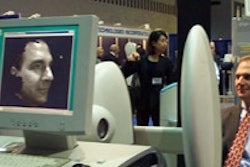Although it has yet to live up to its early promise, digital radiography is slowly building momentum. Vendors are developing new products and strategies to hammer away at the main obstacle to digital radiography: its high price tag. Look for some companies to reduce the capital acquisition price of DR through marketing initiatives such as retrofit and per-scan programs.
Meanwhile, CR is gravitating toward a likely future role in satellite clinics, offices, and other remote locations where full-fledged DR systems aren't financially practical. CR vendors are beginning to emphasize small desktop systems that make digital image acquisition more cost-effective than ever.
Computer-aided detection (CAD) technology, having found success in mammography, is being considered for several other radiography applications. A number of CAD developers are working to adapt their systems, with chest radiography screening set to debut first.
Agfa HealthCare
Agfa will be introducing a new version of its ADC Compact CR reader at this year's show. Called Compact Plus, the new release offers throughput and reliability improvements, according to the Ridgefield Park, NJ-based firm. The new release will replace ADC Compact, effective this month.
In other introductions, Agfa has finalized the shift of its QS workstation to the Windows NT platform, improving both processing power and client-server functionality. The new client-server configuration enables customers to distribute quality control features to ADC client workstations, even on basic PCs, according to Agfa.
Other QS software enhancements include scoliosis imaging capability, stitching software, and new dose monitoring and measurement tools, as well as database management additions that allow for comparing and contrasting Agfa systems across a network. Agfa said it will also emphasize the open architecture of its CR technology, as well as CR's integration with Agfa's Web-based image distribution software.
Work-in-progress CR displays will include an update on the firm's new scanhead technology, including the display of a pre-production scanning engine. Agfa hopes to begin deploying scanhead technology in a single-plate, cassette-based digitizer by the end of 2002, with general availability targeted for the first or second quarter of 2003. Agfa's needle storage phosphor technology will also be presented as a work-in-progress.
In DR developments, Agfa customers can now use the vendor's QS workstation with its ADR Thorax digital radiography system, allowing a single workstation to provide image processing for both CR and DR systems.
Deus Technologies
Deus is a Rockville, MD, developer of CAD systems that has chosen to focus on lung cancer screening rather than mammography. The company’s lead product, RapidScreen RS-2000, will be displayed at the RSNA show for the first time as a commercial product. The system received FDA premarket approval in July.
RapidScreen works in roughly similar fashion to a mammography CAD workstation: Chest films are digitized and analyzed by a computer algorithm, which highlights suspicious areas that have features associated with early-stage lung cancer. These areas are then marked for further review by a radiologist.
Deus claims that in a recent clinical trial of the technology, radiologists using RS-2000 were able to identify 78% of early-stage cancers on chest x-rays. The company said that American Cancer Society data indicate that only 15% of cancers are detected in the early stage.
Deus will be also be discussing RapidDisplay, a new CAD offering for CT applications. RapidDisplay uses software algorithms to provide slice matching between current and prior CT studies, enabling radiologists to compare changes in anatomical structure, according to the company. FDA clearance is pending for RapidDisplay.
Eastman Kodak
Kodak's Health Imaging division will debut two new models of DR systems. In addition, the Rochester, NY-based firm will introduce new CR software that automates quality control testing by users. Other work-in-progress CR applications will also be displayed.
Edge Medical Devices
Flat-panel DR developer Edge is introducing a programmable automatic exposure control (AEC) for its Quix DR retrofit line. The new AEC eliminates the need for equipment rotation when the bucky is adjusted for upright or recumbent exams, according to the Hackensack, NJ-based firm.
Edge is also introducing a tilting wall stand, which allows angular adjustment of the digital bucky from 15° to + 90° . This enables a single digital bucky to perform upright, recumbent, and oblique patient exams, according to Edge.
In other introductions, Edge is showcasing a flexible operator console design that can fit in small spaces, according to the firm. In addition to a typical integrated configuration, the monitor and keyboard can be separated from other elements for placement in a separate control room, according to the company.
Fujifilm Medical Systems USA
Fuji will present its upright digital chest system, ClearView-ES, at this year’s RSNA meeting. The new system features dual-side reading and energy subtraction (ES) technology that enables extraction of image data from both sides of the imaging plate. The resulting images are said to have 30%-40% higher detective quantum efficiency (DQE) and less noise.
ClearView-ES takes one exposure of a patient and then produces three exam displays: soft tissue only, bone and calcified structures without soft tissue, and a standard chest radiograph. By performing the ES processing on the basis of a single exposure, artifacts or inconsistencies due to cardiac or patient movement are eliminated, according to Fuji. The product can process more than 180 images per hour, and features a full 17 x 17-inch detector.
The Stamford, CT-based company is also unveiling Flash IIP, an integrated ID terminal and quality control (QC) console. The console offers on-the-spot reprocessing of images that can be sent to a PACS, direct integration into an institution’s HIS/RIS, remote capabilities, and patient ID and worklist management. The QC-and-forward flexibility of the console can increase department efficiency by delivering images where they are needed most, according to the firm.
GE Medical Systems
GE of Waukesha, WI, will highlight recent major investments in digital x-ray technology based on amorphous silicon flat panels. One such technology is dual-energy subtraction, a new technique for GE’s Revolution XR/d digital radiography system.
Dual-energy subtraction enables radiologists to take two successive x-ray images of the chest in less than a second. The system then generates three images: a standard radiograph, an image of soft tissue with the bone structure removed, and an image of the skeletal system.
The technique helps radiologists detect smaller pathology and reduces the need for additional studies, the company believes. Revolution XR/d’s digital technology also enables a dual-energy subtraction chest study to be conducted with less radiation dose than a conventional CR study, according to the company. Dual-energy subtraction received FDA clearance earlier this year.
Imaging Dynamics
Canadian digital x-ray developer Imaging Dynamics is bringing the latest iteration of its Xplorer system, Xplorer 1700, to Chicago this year. The company is touting image quality that exceeds 4 line pairs/mm, the capability to perform chest and routine radiographs with one detector, and a system that can be retrofitted to existing x-ray generators.
The Calgary, Alberta-based manufacturer has paired its 4K x 4K charge-coupled device (CCD) camera and cesium iodide scintillator with an acquisition workstation it calls Magellan. The workstation features an Intel Pentium III processor, and a 32-GB mirrored redundant array of inexpensive disks (RAID) providing a total of 64 GB of storage on a Microsoft Windows NT platform. A reporting workstation option with a dual processor and dual high-resolution monitor configuration is also available.
An image acquisition software package is also bundled with the workstation. The application features anatomical look-up tables, adaptive contrast enhancement and sharpening algorithms, and support of DICOM print class. An optional DICOM worklist component can be integrated with the software.
The company is targeting Xplorer 1700 for 500-bed hospitals, freestanding imaging centers, and clinics. The list price of Xplorer 1700 (including detector, radiographic stand, and acquisition workstation) is projected to be $175,000 (U.S.). A full-system version (detector, stand, acquisition workstation, x-ray generator, and x-ray tube stand) is slated for delivery at a list price of $245,000.
Next page:
IMCO through Wuestec



















